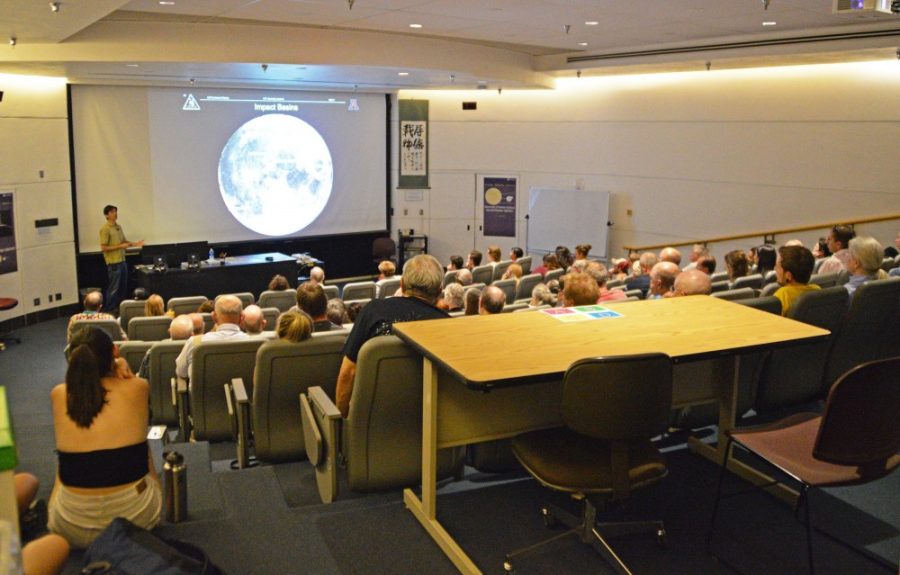Associate professor of the lunar planetary laboratory Jeffrey Andrews-Hanna started his Sept. 6 talk on lunar gravity field mapping with a dose of pop culture.
“If you are familiar with Pink Floyd’s Dark Side of the Moon album, they were talking about lunacy more than lunar science,” Andrews-Hanna said to the crowd of around 150 people.
Andrews-Hanna’s talk centered on how the findings of two probes from NASA’s Gravity Recovery and Interior Laboratory (GRAIL) uncovered surprises beneath the surface of the moon in 2011. Andrews-Hanna was involved in data research from the GRAIL observations.
The two probes orbited the moon and measured the distance between each other, making it possible to map the gravity field more accurately than in earlier missions.
GRAIL’s primary and extended science missions generated the highest resolution gravity field map of any celestial body, according to the NASA website.
By measuring the slight irregularities in the moon’s gravity field, the GRAIL system was able to probe all of the moon, from the surface to the core, according to Andrews-Hanna.
GRAIL also went into an incredibly low orbit, closer than any probe in history according to the NASA website.
RELATED: U.S., Mexico nearing deal on Colorado river water allocation
Andrews-Hanna covered previous methods for studying the surface of the moon, from radio and seismic waves that scratched the surface during manned Apollo missions to the Lunar Prospector Orbiter from the 1980s that returned poor gravity data because of signal loss on far side of the moon.
According to Andrews-Hanna, GRAIL revealed the craters covered up by fissures. The gravity data can be used to measure the distribution of mass, because anything that has mass has a gravity field.
“Since the moon barely has an atmosphere, it is easier to view much of the gravity data using probes like GRAIL,” Andrew-Hanna said. “We have a better gravity field image of the moon than of the Earth.”
Trace amounts of uranium, thorium and plutonium were found in the interior that caused radioactive heat, according to the GRAIL data Andrews-Hanna covered in his lecture. He said that thousands of years ago even more heat emanated from the moon because of these elements.
One of Andrews-Hanna’s current research interests are impact basins. Using the Orientale impact basin on the moon as an example, he explained how researchers can see faults through the lunar crust by using gravity data.
Andrews-Hanna ended his lecture by bridging the connection between the earth and the moon.
“We don’t understand the earth until we understand where the moon came from,” Andrews-Hanna said.
Amanda Becerra, an astronomy and physics freshman, attended the lecture and said she liked the clarity of it.
“He made it very easy for people who may not be astronomy majors to be able to understand what was going on,” Becerra said. “He covered a lot of things in a short period of time, usually that can be hard to understand but he made it very clear.”
RELATED: UA a cappella groups share their voices on campus
Luke Ramieri, a first-year graduate student in the planetary sciences graduate program at LPL, said he enjoyed Andrews-Hanna’s style.
“His style is enthusing. The fact that he can handle such a large room with different kinds of people is very progressive,” Ramieri said. “The fact that he is able to engage with a good sense of humor gives the sign that he is a good teacher.”
Andrews-Hanna’s research focuses on understanding the processes acting on the surfaces and interiors of solid-surface planets and moons in the solar system. He combines analysis of gravity, topography and other remote-sensing datasets with numerical modeling.
His website states his current research interests include terrestrial planet tectonics along with the gravity field and structure of the moon. He also studies impact basins, the volcanoes of Mars, and other varied subjects.
Follow The Daily Wildcat on Twitter









